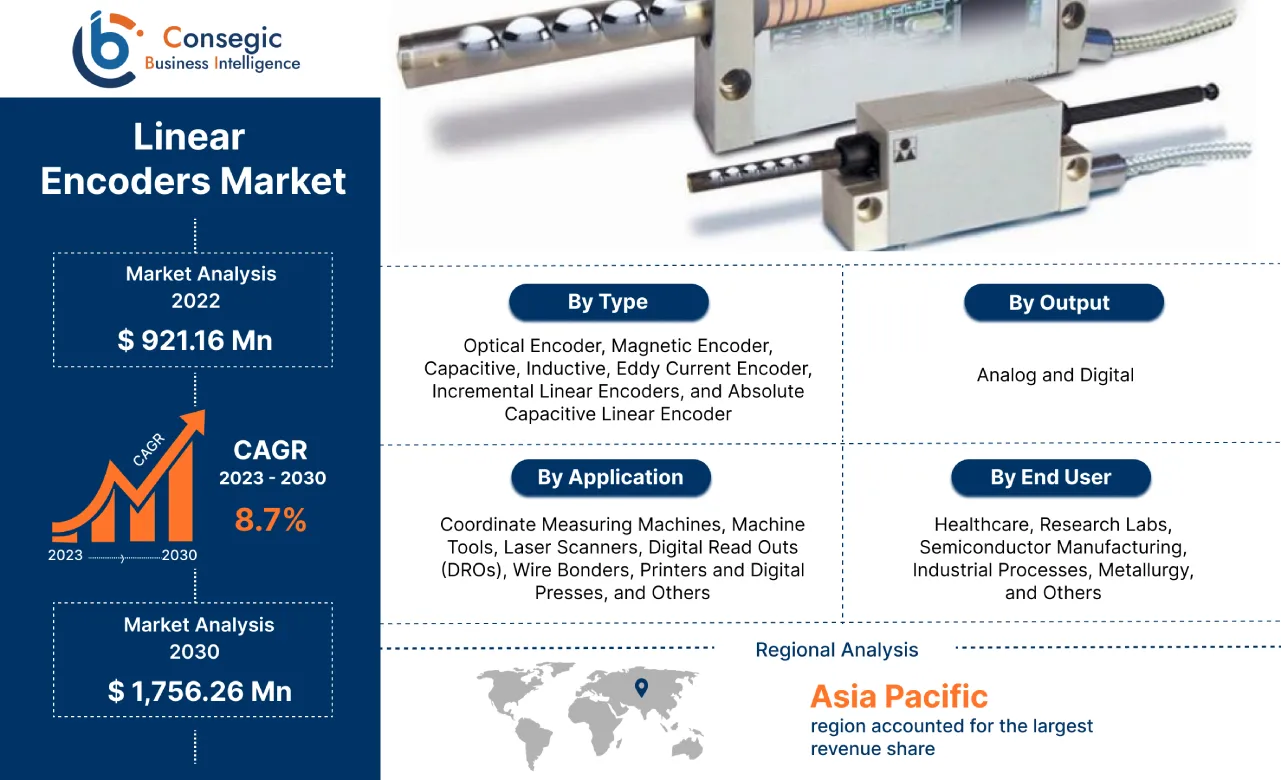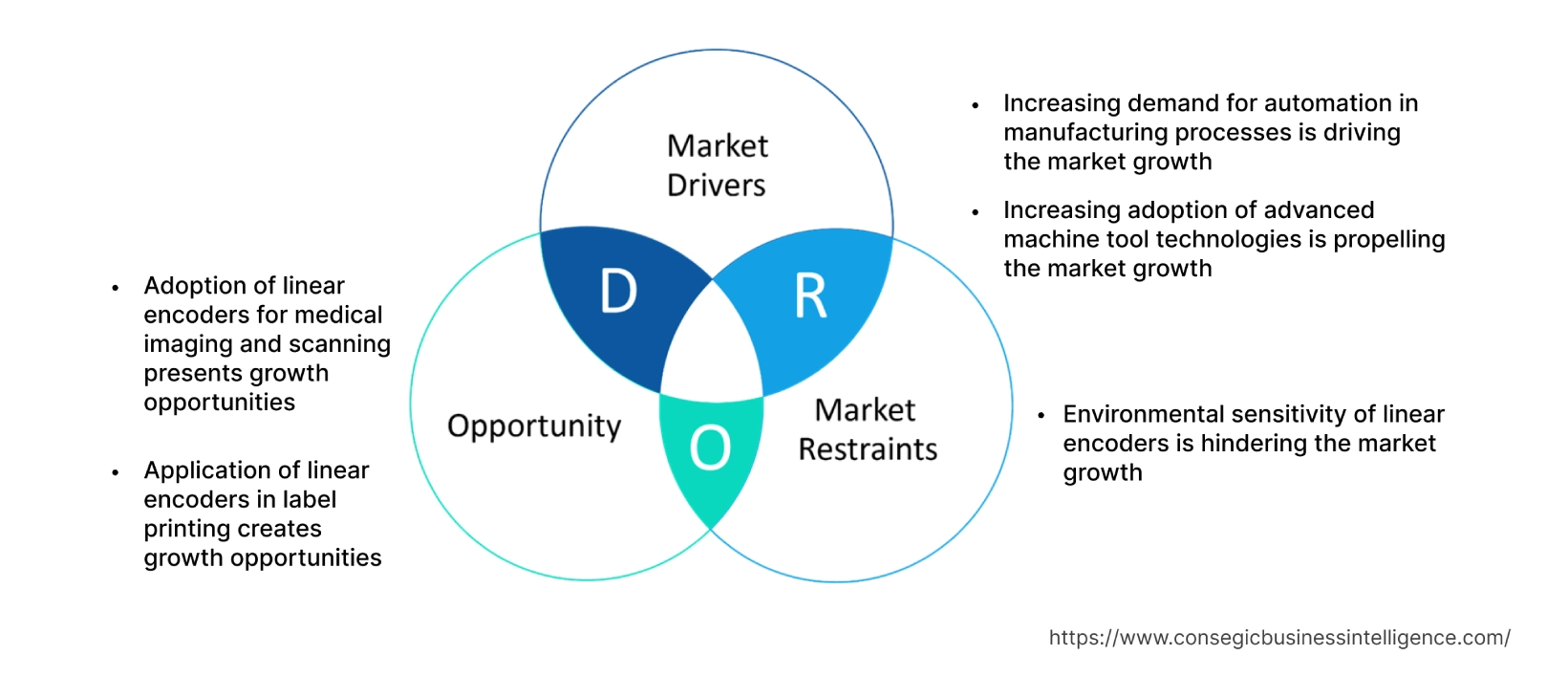- Summary
- Table Of Content
- Methodology
Linear Encoders Market Size :
Linear Encoders Market size is estimated to reach over USD 1,756.26 Million by 2030 from a value of USD 921.16 Million in 2022, growing at a CAGR of 8.7% from 2023 to 2030.
Linear Encoders Market Scope & Overview:
Linear encoder is a sensor deployed in measurement systems to determine the speed, position, and direction of linear motion. Linear encoder detects linear movements as absolute position values without establishing physical contact with the object. Based on the analysis, they consists of a scale and a read head. Consequently, the sensor reads the scale and translates the position into a digital or analog signal that is transformed into a Digital Readout (DRO). Consequently, these encoders are used in motion systems, metrology instruments, inkjet printers and high precision machining tools.
Linear Encoders Market Insights :
Key Drivers :
Increasing demand for automation in manufacturing processes is driving the market expansion
The increasing demand for automation during manufacturing processes to streamline the business operations is driving the development of the market. They play a crucial role in providing accurate position feedback for automated machinery, robotics, and advanced manufacturing processes. Moreover, these encoders provide valuable information about the velocity, direction, and position to operators. Thus, as per the analysis, the increasing adoption of these encoders in industrial processes reduces the chances of defects and variations, thereby resulting in higher productivity levels. For instance, in November 2022, SICK AG launched new encoders called DAX for high-precision detection of piston in hydraulic cylinders to monitor the linear movements in machines. Consequently, the ability of these encoders to provide high level of accuracy is movement detection is driving the develoment and trends of the linear encoders market.
Increasing adoption of advanced machine tool technologies is propelling the market expansion
The increasing adoption of advanced machine tool technologies such as Computer Numerical Control (CNC) machining is accelerating the linear encoders market growth. CNC machining is a manufacturing process in which pre-programmed computer software dictates the movement of factory tools and machinery. Consequently, these encoders are deployed for precise positioning of tools and workpieces in CNC machines. For instance, in March 2020, Fagor Automation introduced two new CNC systems called 8060L and 8070L equipped with linear encoder for laser cutting machines featuring high-performance encoders for cutting a wide variety of structures and shapes. Therefore, based on the analysis, the application of advanced technologies to manufacture complex parts efficiently is driving the trends of the market.
Key Restraints :
Environmental sensitivity of linear encoders is hindering the market expansion
Linear encoders, especially optical encoders, are sensitive to environmental conditions such as dust, dirt, moisture, and temperature variations. Moreover, electrical noise generated due to the continuous operation of machines sends false signals to the encoders, resulting in inaccurate readings. Therefore, the sensitivity of these encoders towards the aforementioned factors affects the accuracy of measurements and the longevity of the encoder, thereby hindering the market development.
Future Opportunities :
Adoption of linear encoders for medical imaging and scanning presents growth opportunities
The adoption of these encoders in medical imaging and scanning systems, such as computed tomography (CT) and magnetic resonance imaging (MRI) is expected to present potential linear encoders market opportunities during the forecast period. These encoders provide precise position location of vital organs in the body. Moreover, as per the analysis, the application of these encoders in MRI cradle position monitoring, MRI robots and MRI phantom training organs is expected to create opportunities and trends during the forecast period.
Application of linear encoders in label printing creates opportunities for the market
The application of these encoders in label printing is expected to present potential opportunities and trends for development of the market during the forecast period. The rising adoption of labels in food and pharmaceutical industry drives the linear encoders market demand in label printing presses for accurate and efficient printing of labels. Moreover, based on the analysis, the adoption of digital printing technology to allow easy customization of the label design is expected to drive the linear encoders market trends during the forecast period.
Linear Encoders Market Report Insights :
| Report Attributes | Report Details |
| Study Timeline | 2017-2030 |
| Market Size in 2030 | USD 1,756.26 Million |
| CAGR (2023-2030) | 8.7% |
| By Type | Optical Encoder, Magnetic Encoder, Capacitive, Inductive, Eddy Current Encoder, Incremental Linear Encoders, and Absolute Capacitive Linear Encoder |
| By Output | Analog and Digital |
| By Application | Coordinate Measuring Machines, Machine Tools, Laser Scanners, Digital Read Outs (DROs), Wire Bonders, Printers and Digital Presses, and Others |
| By End-User | Healthcare, Research Labs, Semiconductor Manufacturing, Industrial Processes, Metallurgy, and Others |
| By Region | North America, Europe, Asia-Pacific, Latin America, and Middle East & Africa |
| Key Players | Baumer Group, Honeywell International, Maxon Motor AG, Newall Electronics Inc., OMRON Corporation, Panasonic Corporation, Rockwell Automation, Inc., Schneider Electric, Sensata Technologies Inc., MEGATRON Elektronik GmbH & Co. KG, NVE Corporation, Heidenhain, Renishaw plc., SICK AG, Fagor Automation |
| Geographies Covered | |
| North America | U.S. Canada Mexico |
| Europe | U.K. Germany France Spain Italy Russia Benelux Rest of Europe |
| APAC | China South Korea Japan India Australia ASEAN Rest of Asia-Pacific |
| Middle East and Africa | GCC Turkey South Africa Rest of MEA |
| LATAM | Brazil Argentina Chile Rest of LATAM |
| Report Coverage | Revenue Forecast, Competitive Landscape, Growth Factors, Restraint or Challenges, Opportunities, Environment & Regulatory Landscape, PESTLE Analysis, PORTER Analysis, Key Technology Landscape, Value Chain Analysis, Cost Analysis, and Regional Trends & Forecast |
Linear Encoders Market Segmental Analysis :
By Type :
Based on the type, the market is segregated into optical encoder, magnetic encoder, capacitive, inductive, eddy current encoder, incremental linear encoders, and absolute capacitive linear encoder. The optical linear encoder segment accounted for the largest revenue share in the year 2022. Optical linear encoders consist of a light source, a scale, and a photoelectric sensor that detects the light passing through the scale. Optical linear encoders provide high-resolution, high-accuracy and flexibility in mounting options such as hollow-shaft, shafted, and hub-shaft. Therefore, the application of optical linear encoders in industrial automation is driving the development of the linear encoders market trends.
The incremental linear encoders segment is anticipated to emerge as the fastest-growing segment during the forecast period. Based on the analysis, incremental linear encoders provide position feedback by generating incremental signals as the position changes. Based on the analysis, these encoders comprise of A and B quadrature signals that provides information about both direction and magnitude of movement. Thus, the application of incremental linear encoders in machine tools, CNC machining centers, semiconductor manufacturing equipment is propelling the trends of the linear encoders market.
By Output :
Based on the output, the market is bifurcated into analog and digital. Analog segment accounted for the largest revenue share in the year 2022. Analog linear encoders produce output in the sine and cosine quadrature signals. The signals are monitored using an oscilloscope in XY mode to monitor the movements of a wide variety of industrial machines. For instance, in November 2020, Renishaw plc. launched new linear encoder called QUANTiC with analogue output option in encoder read heads that allows signal manipulation inside the electronics devices coupled with built-in calibration options. Moreover, the lower bandwidth of analog signals minimizes Electromagnetic compatibility (EMC) emissions, resulting in market trends.
The digital segment is expected to witness the fastest CAGR during the forecast period. The high measurement accuracy, improved noise immunity, and low latency of digital signals are propelling the development of this segment. The digital signals produced by linear encoders divide the sine and cosine output of analog signals into precise scale periods, thereby providing a high measurement resolution. Consequently, the signals are processed digitally, thereby improving noise immunity. Therefore, the increasing adoption of built-in digital signal processing in incremental encoders for providing information about the position of electronics is driving the expansion of the market.
By Application :
Based on the application, the market is separated into coordinate measuring machines, machine tools, laser scanners, digital read outs (DROs), wire bonders, printers and digital presses, and others. Printers and digital presses segment accounted for the largest revenue share in the year 2022. These encoders in printers are used to monitor the position of print-head as it moves along the page. Consequently, the information stored in the printers' control software is used to ensure that the image and text is printed in the correct location. Thus, the application of these encoders to monitor the location of print-head is propelling the development of the market.
The machine tools segment is anticipated to witness the fastest CAGR during the forecast period. The advancements in machine tool technology and the increasing demand for high productivity in industries is driving the development of the market. Precision machining tools such as CNC machining centers, milling machines, and grinding machines are deployed with these encoders to provide precise position feedback for tool positioning, workpiece movement, and overall machine control. Moreover, the ability of these encoders to function in diverse industrial environments is driving the expansion of the market.
By End-User :
Based on the end-user, the market is segregated into healthcare, research labs, semiconductor manufacturing, industrial processes, metallurgy, and others. The semiconductor manufacturing segment accounted for the largest linear encoders market share of 31.3% in the year 2022. These encoders play a crucial role in semiconductor manufacturing industry for wafer handling and inspection systems. The encoders ensure accurate alignment and positioning of semiconductor wafers and components, contributing to the production of high-quality integrated circuits and semiconductor devices. Consequently, the application of these encoders for manufacturing semiconductor devices of accurate shapes and sizes is accelerating the expansion of the market.
The industrial segment is anticipated to emerge as the fastest growing segment during the forecast period. The increasing adoption of these encoders in manufacturing and packaging purposes is driving the growth of industrial segment. These encoders play a crucial role in machine tools, robotics, automated assembly systems, and other industrial machinery to provide accurate position feedback, thereby improving the productivity of the industrial operations. For instance, in May 2023, Heidenhain announced to showcase encoders for robotics applications combining motor speed and position in a single product. Thus, the adoption of these encoders to automate measurement processes in manufacturing industries is contributing to the growth of the market.
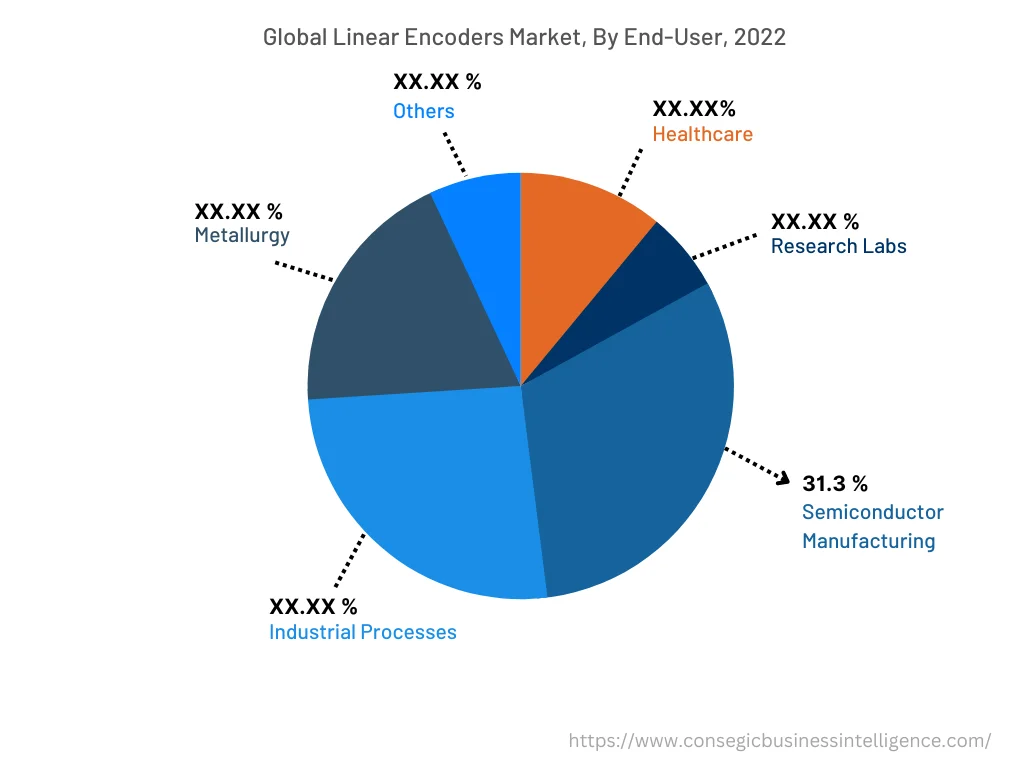
By Region :
The regional segment includes North America, Europe, Asia Pacific, Middle East and Africa, and Latin America.
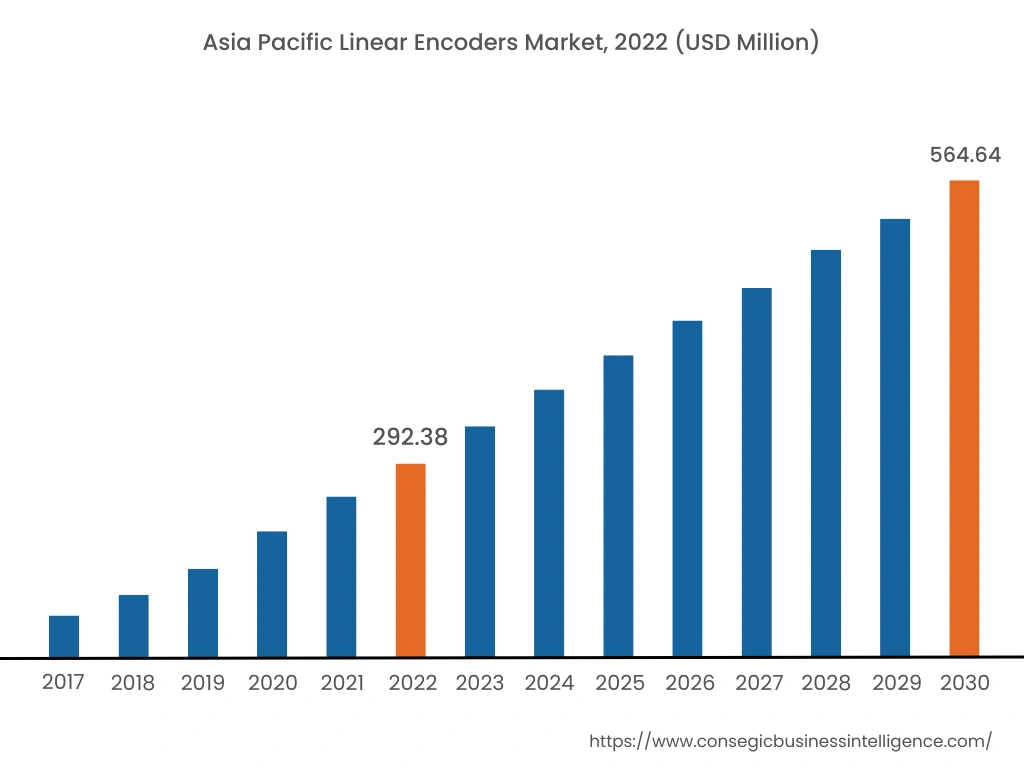
The Asia-Pacific region accounted for the largest revenue share of USD 292.38 million in 2022 and is expected to reach USD 564.64 million in 2030, registering a CAGR of 8.9% during the forecast period. Additionally, in the region, China accounted for the largest revenue share of 32.56% in the year 2022. The increasing number of industrial activities in sectors including automotive, electronics, and machinery is driving the growth of the market. Based on the linear encoders market analysis, manufacturers are increasingly deploying these encoders to support precision positioning, automation, and quality control in manufacturing processes. Moreover, the Asia-Pacific region is anticipated to emerge as the fastest growing segment during the forecast period. The rapidly growing semiconductor industry in Asia-Pacific region is driving the demand for these encoders for precise measurements and control. For instance, according to Malaysian Investment Development Authority (MIDA), Global semiconductor industry sales rose by 21.1% in 2022 from USD 42 billion to USD 50.9 billion. As a result, the demand for these encoders for accurate alignment and positioning during manufacturing of semiconductors is driving the growth of the regional market.
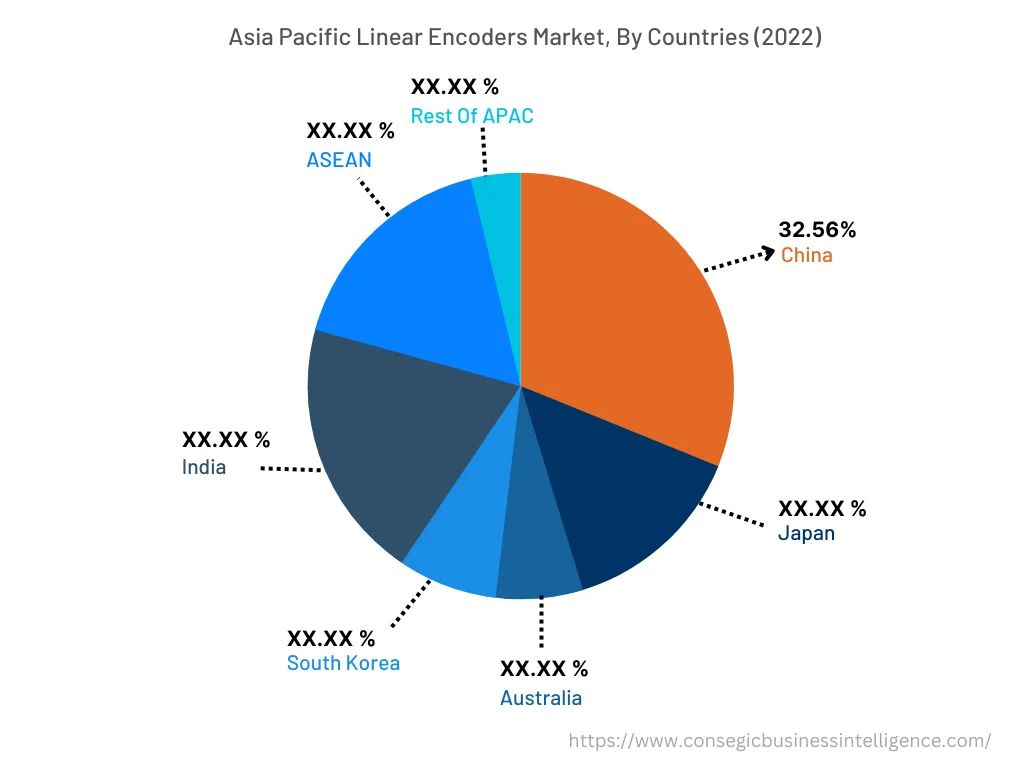
Top Key Players & Market Share Insights:
The global linear encoders market is characterized by the presence of major players providing a wide variety of encoders to the domestic and international markets. Key players are adopting various business strategies such as product innovation, research and development (R&D), and application launches to accelerate the growth of the linear encoders market. Key players in the global linear encoders industry include-
- Baumer Group
- Honeywell International
- MEGATRON Elektronik GmbH & Co. KG
- NVE Corporation
- Heidenhain
- Renishaw plc.
- SICK AG
- Fagor Automation
- Maxon Motor AG
- Newall Electronics Inc.
- OMRON Corporation
- Panasonic Corporation
- Rockwell Automation, Inc.
- Schneider Electric
- Sensata Technologies, Inc.
Recent Industry Developments :
- In November 2021, MEGATRON Elektronik GmbH & Co. KG launched new encoder called FHx58 equipped with high-quality ball bearings provide resistance to salt spray, cleaning agents and disinfectants during food, pharmaceuticals and offshore applications.
- In September 2020, NVE Corporation launched new series of tunnel magnetoresistance sensors applied to both linear and rotary encoders feature simple interfaces to provide high precision for motion, speed, and position sensing in automotive sensors.
Key Questions Answered in the Report
What is Linear Encoder? +
Linear encoder is a sensor used in measurement systems to determine the position, speed, and direction of linear motion.
What specific segmentation details are covered in the linear encoders report, and how is the dominating segment impacting the market growth? +
By end-user segment has witnessed semiconductor manufacturing as the dominating segment in the year 2022, due the adoption demand for precise and accurate semiconductors in electronic devices.
What specific segmentation details are covered in the linear encoders market report, and how is the fastest segment anticipated to impact the market growth? +
By type segment has witnessed incremental linear encoder as the fastest-growing segment during the forecast period due to its ability to provide information about both the direction and magnitude of movement.
Which region/country is anticipated to witness the highest CAGR during the forecast period, 2023-2030? +
Asia-Pacific region is expected to register fastest CAGR growth during the forecast period due to the rapidly growing semiconductor industry in the region.
